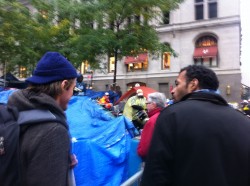Blog:
Decoding Collaboration Part 3: Collective impact deconstructed
“The expectation that collaboration can occur without a supporting infrastructure is one of the most frequent reasons why it fails.” –Fay Hanley Brown, John Kania and Mark Kramer, Stanford Social Review

Occupy New York staged in the financial district, directly across from the World Trade Center’s reconstruction effort. Credit Lisa Skube
Jo Ellen Green Kaiser, who leads The Media Consortium, has been going deep on collaboration in her work. Here, she generously offers a number of insights, with this the third of her three-part series:
News Collaborations:
Part I: What do we mean by the word “collaboration”?
Part II: How does collaboration create impact?
Part III: How might collaboration shape the future of journalism? (see below)
There is a reason why the virtues of editorial collaboration have been championed by any number of media watchers in publications like Mediashift, NiemanLabs, J-Lab, and Journalism Accelerator. Collaboration is seen as the best way to leverage scarce resources in order to create more impact than any of the participants could do individually.
To innovate around impact, the journalism world will need philanthropists who understand that collaboration also requires resources, not only for the outlets that collaborate, but for the backbone organizations that support these collaborations.
In this post, I’ll detail the Media Consortium’s 2012 May Day collaboration to demonstrate how one type of high-impact collaboration can be organized, the investment ours required, and the return it offers.
Collective Impact
When we parse what we mean by collaboration, we find that different types of collaboration produce different types of impact. One of the forms of collaboration that presents a new pathway for journalism is what I’ve called horizontally networked collaboration.
In a horizontally networked collaboration, a number of different outlets come together to report on a specific issue. As these diverse outlets combine their editorial, they can emerge with entirely new approaches to the content at hand—asking new questions, locating different sources, developing innovative formats for presenting information. This intervention in reporting can, in turn, inspire the public to understand and think about the issue at hand in new ways. That result is what sociologists call “collective impact.”
The Media Consortium’s May Day 2012 collaboration was our best effort to date to create collective impact using a horizontally networked collaboration.
May Day 2012: How might journalists best cover this social movement?
One response to the Great Recession was the rise of the Occupy movement. After “occupying” a large number of cities in the fall of 2011, the movement seemed to go dormant in the winter, yet promised a resurgence on May Day 2012.
Some outlets ignored the May Day plan; many thought Occupy was not active. Others prepared to give a short history of the movement, and to send a reporter to check out whether anything was happening on May Day. Media outlets were poised to cover the response to Occupy as an event, rather than report out on Occupy as a social movement.
Media Consortium members felt something more was going on. They noticed many Occupy members had moved from camping out at city halls to working on discreet issues, including home foreclosures, student debt, money in politics, and the minimum wage. May Day is traditionally a worker’s holiday and had become in the past decade a day focused especially on ethnic immigrant workers. Yet many in the African-American and Latino communities had accused Occupiers of being too white-centric. Would Occupiers pick up on themes of labor, racial inequity and economic justice? Would this populist movement join with labor?
Starting with these shared questions, Media Consortium members decided to join forces to report on May Day.
May Day 2012: The details of a horizontally networked collaboration
Our first task was to create a pop-up website, Mediaforthe99percent.com, with a map to which more than 45 news outlets contributed information on where May Day events would be taking place, as well as content they had previously written about Occupations in different cities.
Free Speech TV (FSTV) offered to run a four-hour, free, live-stream broadcast on May Day, with reporters from more than 20 outlets contributing on-air reports focusing on the interactions between Occupiers and labor. Reporters agreed to use a common Twitter hashtag on May Day for their reporting, with the material collected by a news team in San Francisco that built a Storify around their tweets. Finally, the San Francisco news team added arrests during May Day to the map, in order to draw attention to the project.
All of this work was organized by a team of staffers from more than 20 news outlets, facilitated and resourced by Media Consortium staff. Critically, however, the editorial content was not controlled by Media Consortium staff—the collaboration was entirely horizontal, with editors sharing content but not taking direction from anyone outside their own outlet.
May Day 2012: Collective impact
The result of the May Day effort demonstrated how a horizontally networked collaboration achieved collective impact. More than 65 outlets embedded the May Day map on their websites. More than 25,000 unique viewers checked out the Storify, while the FSTV show reached more than 20 million homes.
With Media Consortium’s collaborative reporting, May Day was revealed as a national phenomena, with protests from Daytona Beach to Seattle, Kalamazoo to Birmingham. National media were scooped, unable to write off the event or to focus their coverage just on the coasts. Instead, the story changed from some New Yorkers trying to “breathe new life” into a movement to widespread coverage of a national event.
Collective impact by definition provides new ways of looking at—and solving–complex social problems. TMC’s May Day collaboration demonstrates some of these effects. Occupy May Day 2012 may have been the last hurrah for the Occupy movement. Yet the people and the tactics of Occupy have fueled the green shoots, emboldening the fast food workers strike in the summer of 2013. By mapping the relationship between the labor and Occupy movements on May Day, Media Consortium members expanded reporting that may have contributed to the conversations that led to these movements’ growing rapprochement with each other.
Most of all, the act of working together changed the members of the Media Consortium. Reporters discovered the benefit of sharing information with other reporters in order to improve their own stories. Social media curators learned the power of a shared media site to which they could link in and link out. Publishers, producers and editors noticed that working collectively on May Day led to increased hits and mentions for their outlets — that there was a tangible value to working collaboratively.
Within a year after Occupy May Day, Media Consortium members had asked staff members to help them set up issue-based working groups with the aim of exploring future horizontally networked collaborations. This one event sparked a new approach to media-making.
Horizontal Collaboration: Providing the backbone
 Can collective impact unleash untapped potential?
Can collective impact unleash untapped potential?

Jo Ellen Green Kaiser is the executive director of The Media Consortium. Green-Kaiser’s rich background includes a BA from Yale, a PhD from the University of California, with an impressive body of work across numerous independent magazines; she is a leading figure in Jewish media and an expert on the Jewish social justice movement.
The May Day effort happened because the individual outlets were supported by the Media Consortium as a backbone organization. Media Consortium staff coordinated a pool of 50-plus reporters and social media staff from 21 outlets to contribute to the reporting and promotion of the day. Media Consortium staff set up a listserv for internal communications, held conference calls with sub-groups, set up the microsite, oversaw the data visualization work (from somewhere like https://www.paxata.com/data-validation/), helped produce the TV show, and assembled the day-of staff for the Storify.
Individual outlets need this kind of shared infrastructure to enable networked collaborations that work. No matter how willing the staff or how awesome the digital toolbox, without assigned external support none of these individuals would have had the energy or organizational capacity to tackle the complexity, maintain the communications or erect the shared reporting and measurement systems that a centralized media Occupy May Day effort required.
The coordination costs for infrastructure is real. Media Consortium staff invested more than 180 staff hours on the Occupy May Day project. We hired freelancers to run the social media promotions, create the data visualization and produce the Storify. Not including the donation of volunteer time or earned media, hard costs to The Media Consortium alone exceeded $7,000.
After the event, the Media Consortium interviewed managers at the 21 outlets that supported the effort. They told us that they also invested in additional, uncompensated overhead costs to run the collaboration—approximately 20 hours per staffer, with some putting in more hours, some less. If those costs had been reimbursed, minimal total cost of the project would have been north of $32,000 – and that was for a collaboration around one day, not an ongoing effort.
Traditionally, funders investing in media have preferred to fund specific organizations and specific issues, where the answers to such questions appear clearer, even if the potential benefits, or hard evidence of impact, are not as great.
What journalists need now, for the future of journalism, is more support for this kind of infrastructure to deepen and expand sector level sustainability.
An increasing number of philanthropists have seized this opportunity afforded by networked collaborations: for example, the Funders’ Committee for Civic Participation, Public Interest Projects, the Environmental Grantmakers Association, and others. These funders, understanding the return on investment collective that impact offers, have incentivized collaboration among their grantees by funding both the outlets and their supporting organizations. There are some funders in the journalism space creating impact, with missions that include support of collaborative networks, such as The Patterson and Dodge Foundation.
I started this series of essays inspired by John Bracken’s question, “Can or should news collaboration be forced by funders?” I propose we turn that question on its head. Does journalism need funders to invest in strategic horizontal networked collaborations that lead to greater collective impact? Without capacity-building dollars for infrastructure, relevant projects that provide critical mass to sustain efforts in aggregate simply will not get off the ground.
In a time where more of the same is yielding less return, might it be time to consider more systemic approaches for journalism? Let’s apply hard evidence from other sectors for the ultimate return of greater transformative capabilities that enable news and information not to just survive, but thrive.
How much is it worth to accurately report on a complex social movement in a way that changes people’s thinking and potentially provides for new relationships and connections? How do we begin to measure collective impact, and understand the ROI it can deliver? What other examples do you have to expand or deepen our thinking?
 With an overarching goal in increase effectiveness, back in 2005 a couple dozen media thought leaders across platforms came together to discuss “Independent Media and the Future of Democracy.” In 2006 this group “coalesced” around a shared mission to “amplify independent media’s voice, increase our collective clout, leverage our current audience and reach new ones,” The Media Consortium is a project-based, membership organization. Projects focus on building connections, infrastructure and amplifying independent media voices.
With an overarching goal in increase effectiveness, back in 2005 a couple dozen media thought leaders across platforms came together to discuss “Independent Media and the Future of Democracy.” In 2006 this group “coalesced” around a shared mission to “amplify independent media’s voice, increase our collective clout, leverage our current audience and reach new ones,” The Media Consortium is a project-based, membership organization. Projects focus on building connections, infrastructure and amplifying independent media voices.










Weigh In: Remember to refresh often to see latest comments!
1 comment so far.
Beyond fun, real collaboration takes resources, hard work and strategic commitment – there are a few particularly strong leaders working toward shared outcomes, folks we are so grateful to – like the folks at Free Press, or Electronic Frontier Foundation, or Journalism That Matters, the National Freedom of Information Coalition and their critically important state operatives, Investigative Reporters & Editors, to name JUST a few. JA thanks Jo Ellen for working with us to share this series, we encourage discussion in this thread from those of you out there in the trenches – hard pressed to find investors interested in the coordination we know larger, sector level impact collaboration requires – what do you see working and what frustrates you? We’d love to hear from others – what do you see working, how might we remove barriers and accelerate greater collaborative gains?